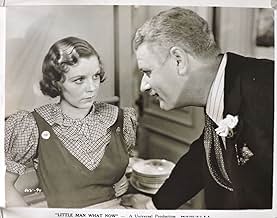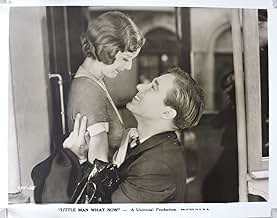Agrega una trama en tu idiomaA young couple struggling against poverty must keep their marriage a secret in order for the husband to keep his job, as his boss doesn't like to hire married men.A young couple struggling against poverty must keep their marriage a secret in order for the husband to keep his job, as his boss doesn't like to hire married men.A young couple struggling against poverty must keep their marriage a secret in order for the husband to keep his job, as his boss doesn't like to hire married men.
- Premios
- 4 premios ganados en total
- Dirección
- Guionistas
- Todo el elenco y el equipo
- Producción, taquilla y más en IMDbPro
Argumento
¿Sabías que…?
- TriviaBased on the 1932 novel of the same name by Hans Fallada
- ConexionesReferenced in Wake Up and Dream (1934)
Opinión destacada
This is a sadly unknown and obscure film classic from the 1930s and one of my own favorites of all Frank Borzage's love stories.
A very sad and heartbreaking tale of a German couple surviving in a Nazi-occupied town in 1920s Germany, "Little Man, What Now?" was the first Borzage film to attack Hitler and the horrors of Nazism, prefiguring the director's later anti-Nazi masterpieces like "Three Comrades"(1938), "The Mortal Storm"(1940) and "Till We Meet Again"(1944).
"Little Man" is a painfully realistic and terrifying experience, especially the second half; and yet strangely full of hope and affirmation. Margaret Sullavan is as always luminous and touching in her portrayal of Lammchen Pinneberg. It is interesting to compare "Little Man" with Sullavan's other Borzage films like "Three Comrades" and "The Mortal Storm." There's something about her sweet innocence, devotion, and luminosity that works well with Borzage's soft-focus, anti-Nazi attitude. The glittering white dress she wears half-way throughout the film seems to suggest a symbol of light and hope (however transient) for Montgomery and against the brutal 1920s depression milieu, the same way Loretta Young's heartbreaking devotion and sweetness are intended to rescue Spencer Tracy's tough, smart-alecky personality in Borzage's 1933 masterwork "Man's Castle."
As with "Man's Castle", the Depression and, particularly in this case, Nazism are less physical than a spiritual or emotional threats to Borzage's lovers. Despite the bleak, depressing reality the characters have to surpass, both "Little Man" and "Man's Castle" retain Borzage's tender touch and humanity, inviting audience forgiveness for his characters' fragility and vulnerability.
This film will break your heart and should never be missed.
A very sad and heartbreaking tale of a German couple surviving in a Nazi-occupied town in 1920s Germany, "Little Man, What Now?" was the first Borzage film to attack Hitler and the horrors of Nazism, prefiguring the director's later anti-Nazi masterpieces like "Three Comrades"(1938), "The Mortal Storm"(1940) and "Till We Meet Again"(1944).
"Little Man" is a painfully realistic and terrifying experience, especially the second half; and yet strangely full of hope and affirmation. Margaret Sullavan is as always luminous and touching in her portrayal of Lammchen Pinneberg. It is interesting to compare "Little Man" with Sullavan's other Borzage films like "Three Comrades" and "The Mortal Storm." There's something about her sweet innocence, devotion, and luminosity that works well with Borzage's soft-focus, anti-Nazi attitude. The glittering white dress she wears half-way throughout the film seems to suggest a symbol of light and hope (however transient) for Montgomery and against the brutal 1920s depression milieu, the same way Loretta Young's heartbreaking devotion and sweetness are intended to rescue Spencer Tracy's tough, smart-alecky personality in Borzage's 1933 masterwork "Man's Castle."
As with "Man's Castle", the Depression and, particularly in this case, Nazism are less physical than a spiritual or emotional threats to Borzage's lovers. Despite the bleak, depressing reality the characters have to surpass, both "Little Man" and "Man's Castle" retain Borzage's tender touch and humanity, inviting audience forgiveness for his characters' fragility and vulnerability.
This film will break your heart and should never be missed.
- Kalaman
- 30 sep 2002
- Enlace permanente
Selecciones populares
Inicia sesión para calificar y agrega a la lista de videos para obtener recomendaciones personalizadas
Detalles
- Fecha de lanzamiento
- País de origen
- Idioma
- También se conoce como
- ¿Y ahora, qué?
- Locaciones de filmación
- Productora
- Ver más créditos de la compañía en IMDbPro
- Tiempo de ejecución1 hora 38 minutos
- Color
- Relación de aspecto
- 1.37 : 1
Contribuir a esta página
Sugiere una edición o agrega el contenido que falta

Principales brechas de datos
By what name was Little Man, What Now? (1934) officially released in Canada in English?
Responda




































